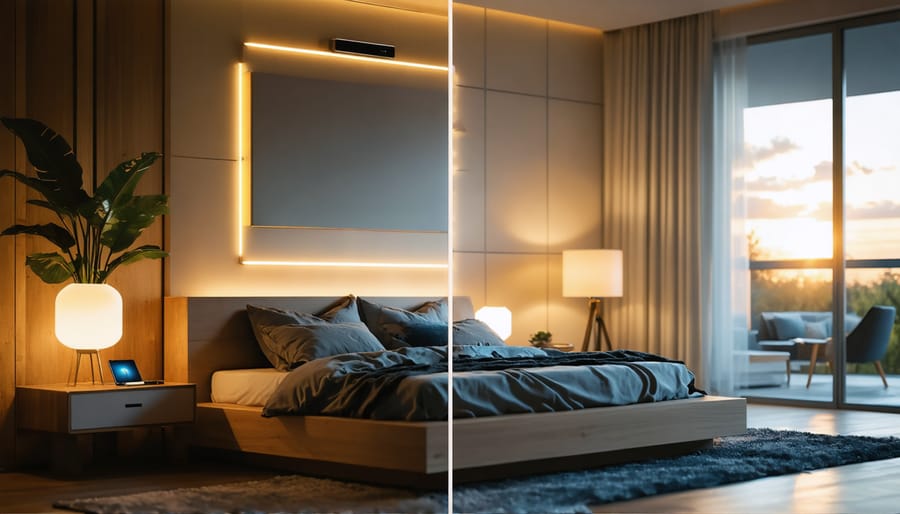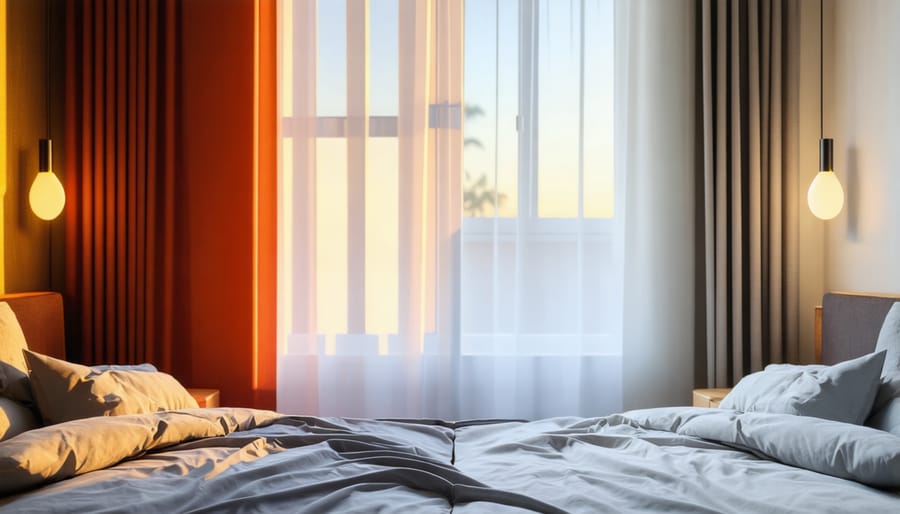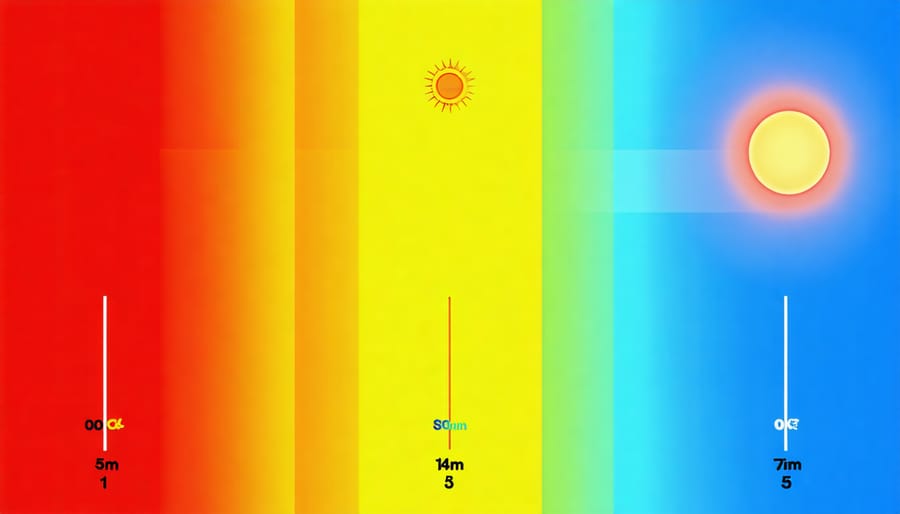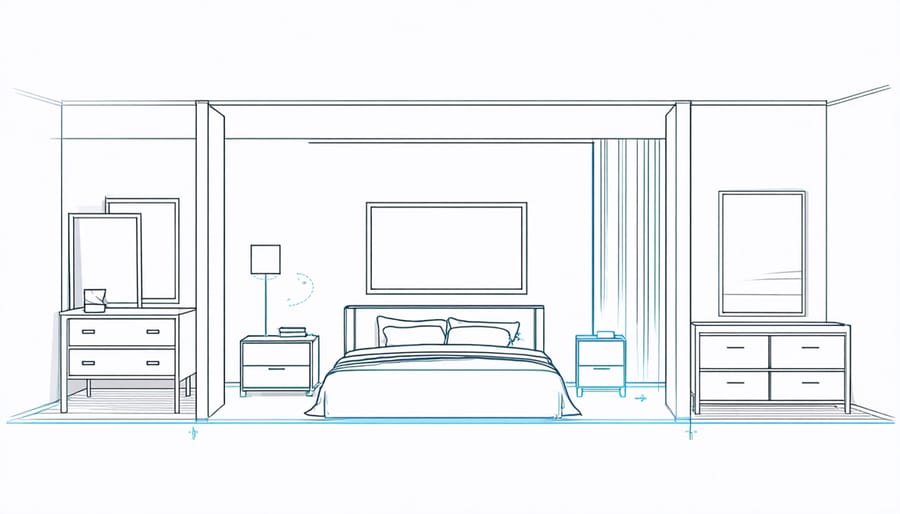
Smart Bedroom Lights That Transform Your Sleep (And Your Morning)
Transform your bedroom into a personalized sanctuary with modern integrated lighting solutions that adapt to your lifestyle. Smart bedroom lighting revolutionizes how we wake up, wind down, and create ambiance, offering precise control over brightness, color temperature, and timing. Beyond mere convenience, these intelligent fixtures work with your natural circadian rhythm, gradually brightening to simulate sunrise for gentle morning awakening, and slowly dimming in the evening to promote better sleep quality. Whether you’re an early riser, night owl, or somewhere in between, smart lighting technology seamlessly integrates with your existing home automation system, responding to voice commands, smartphone apps, or preset schedules to create the perfect atmosphere for any moment of your day.
Why Your Bedroom Needs Smart Lighting
Better Sleep Through Smarter Light
Smart lighting isn’t just about convenience – it’s a powerful tool for better sleep. Our bodies naturally respond to light changes throughout the day, and smart bulbs can work with these natural rhythms instead of against them. By mimicking natural sunlight patterns, smart lights help maintain your circadian rhythm, the internal clock that governs your sleep-wake cycle.
In the evening, you can program your smart lights to gradually shift to warmer, dimmer tones, signaling to your body that it’s time to wind down. This reduction in blue light exposure helps your brain produce melatonin, the hormone responsible for sleep. Many smart lighting systems offer preset “sleep schedules” that automatically adjust throughout the evening, transitioning from energizing bright white light to a soft, warm glow.
Morning routines benefit too. Instead of jarring alarm clocks, smart lights can simulate a natural sunrise, gradually brightening your room to help you wake up naturally and feel more refreshed. This gentle approach to waking helps regulate your sleep patterns and can improve your overall sleep quality.

Wake Up Naturally, Not Jarred
Imagine waking up gradually to a simulated sunrise instead of being jolted awake by a harsh alarm. Smart bedroom lights can recreate the natural dawn experience, helping your body ease into wakefulness just as nature intended. These gentle wake-up sequences typically begin 15-30 minutes before your set wake time, slowly increasing brightness to simulate the rising sun.
This natural approach to waking up works with your body’s circadian rhythm, triggering the gradual release of cortisol and other wake-promoting hormones. The result? You’ll feel more refreshed and alert, rather than experiencing that groggy, disoriented feeling that comes from sudden awakening.
Most smart lighting systems offer customizable wake-up programs. You can adjust the duration of the sunrise simulation, choose your preferred light colors (from warm amber to bright daylight), and even pair the lighting with gentle nature sounds. Some systems also track your sleep cycles to determine the optimal wake-up time within your set window, ensuring you’re roused during a lighter sleep phase.
For best results, combine this feature with evening wind-down lighting to create a complete 24-hour lighting schedule that supports your natural sleep-wake cycle.
Essential Smart Light Features for Your Bedroom
Color Temperature Control
Color temperature plays a crucial role in how we feel and function throughout the day. Smart bedroom lights offer the ability to adjust from warm to cool temperatures, mimicking natural light patterns and supporting your body’s circadian rhythm.
Warmer temperatures (2700K-3000K) create a cozy, relaxing atmosphere perfect for winding down in the evening. This yellowish-orange glow reduces blue light exposure, which can interfere with melatonin production – your body’s natural sleep hormone. Setting your smart lights to gradually shift to these warmer tones as bedtime approaches helps prepare your body for rest.
During the day, cooler temperatures (4000K-5000K) promote alertness and productivity. This crisp, bright light resembles natural daylight and can help you feel more energetic when waking up or getting ready in the morning. Many smart lighting systems include automated schedules that transition between these temperatures throughout the day.
The real magic happens when you program your lights to follow your daily routine. For example, you can set them to slowly brighten with cool light in the morning, mimicking sunrise, and gradually warm up in the evening, helping you naturally transition to sleep. This feature is particularly beneficial during darker winter months or for rooms with limited natural light.
Remember that everyone responds differently to light temperatures, so take time to experiment with different settings to find what works best for your comfort and sleep schedule.

Automation and Scheduling
One of the most powerful features of smart bedroom lights is their ability to create automated routines that match your daily schedule. Setting up energy-efficient lighting control through automation not only enhances convenience but also helps maintain healthy sleep patterns.
Start by programming your lights to gradually brighten in the morning, mimicking natural sunrise. This gentle wake-up call helps regulate your circadian rhythm and makes getting out of bed more pleasant. You can set different schedules for weekdays and weekends, ensuring your lights align with your varying routines.
Throughout the day, your smart lights can automatically adjust their brightness and color temperature. For example, program them to shift to cooler, more energizing tones during your morning routine, then transition to warmer, more relaxing hues as bedtime approaches.
Create evening routines that gradually dim the lights an hour before bed, signaling to your body that it’s time to wind down. You can also set up vacation modes that simulate occupancy while you’re away, or trigger lights to turn on automatically when you arrive home after dark.
Most smart light systems allow you to create these schedules through their companion apps, making it easy to adjust and fine-tune your routines as needed. You can even sync your lights with other smart home devices, like motion sensors or your phone’s location, for truly responsive automation.
Voice and App Control
One of the most convenient features of smart bedroom lights is their seamless smart home integration with popular voice assistants like Alexa, Google Assistant, and Siri. Simply saying “Turn off bedroom lights” or “Dim lights to 50%” lets you control your lighting without leaving the comfort of your bed. Most smart light brands offer dedicated apps that transform your smartphone into a powerful remote control, allowing you to adjust brightness, color, and schedules from anywhere.
These apps typically include features like preset scenes for different activities (reading, relaxing, or waking up), customizable schedules that align with your daily routine, and vacation modes to simulate occupancy while you’re away. You can group multiple lights together, creating synchronized lighting effects across your bedroom or entire home.
For more advanced users, many smart lights work with automation platforms like IFTTT or Home Assistant, enabling complex routines. For example, you can set your lights to gradually brighten as your morning alarm goes off, or automatically dim when your smart TV starts playing a movie. The ability to control your lighting through multiple interfaces ensures you’ll always have a convenient way to create the perfect bedroom ambiance.
Setting Up Your Smart Bedroom Lights
Strategic Light Placement
Strategic placement of smart lights can transform your bedroom from a basic sleeping space into a versatile, mood-enhancing sanctuary. Start with ambient lighting by installing smart LED strips behind your headboard or along the crown molding to create a soft, diffused glow that doesn’t overwhelm the space.
For task lighting, position smart bedside lamps on your nightstands – ideally at shoulder height when seated in bed for optimal reading light. If you’re short on surface space, consider wall-mounted smart sconces on either side of the bed. These provide focused illumination without cluttering your nightstand area.
Closet and dressing areas benefit from motion-activated smart light strips or puck lights. Install these inside closet doors or under shelving to automatically illuminate your wardrobe when needed. For vanity or dresser areas, smart light bars or bulbs with color-temperature adjustment capabilities work best when mounted at face height to provide even, shadow-free lighting.
Don’t forget about pathway lighting – small motion-sensing smart lights near the floor can guide you safely during nighttime bathroom trips without disturbing your sleep patterns. A smart ceiling fixture as your primary light source should be centered in the room, but consider installing it with a dimmer function for maximum flexibility.
Remember to position any smart sensors or motion detectors in corners where they have the best coverage of the room’s entry points and high-traffic areas.

Creating the Perfect Bedtime Routine
Creating the perfect bedtime routine with smart lighting is easier than you might think. By setting up smart automation routines, you can program your lights to support your natural sleep-wake cycle.
Start by scheduling your lights to dim gradually beginning 2-3 hours before bedtime. Set warm, amber tones around 7-8 PM to signal to your body that evening is approaching. Program the brightness to decrease by 25% every 30 minutes until reaching a soft glow about an hour before bed.
For morning routines, reverse the process. Schedule your lights to begin brightening 30 minutes before your desired wake time, starting with a gentle warm glow that gradually shifts to energizing bright white light. This simulates a natural sunrise, helping you wake up more naturally and energetically.
Don’t forget to include motion-activated night lights for those midnight trips to the bathroom. Set these to a very dim, warm red that won’t disrupt your sleep cycles. You can also create special routines for weekends or vacation days when you want to sleep in.
Remember to adjust these schedules seasonally to align with natural daylight changes, and always include manual override options for those unexpected late nights or early mornings.
Common Smart Light Mistakes to Avoid
Light Intensity Mishaps
Getting your smart bedroom light’s intensity just right can be tricky, and many users stumble into common pitfalls. One frequent mistake is setting the brightness too high for evening hours, which can interfere with your body’s natural melatonin production. Many people unknowingly keep their lights at full intensity until bedtime, not realizing this can make it harder to fall asleep.
Another common error is mismatching the light intensity with daily activities. For instance, setting dim lighting during morning routines can make it difficult to apply makeup or choose outfits accurately. Some users also forget to adjust their automated schedules during seasonal changes, leading to lights that are too bright or too dim for the natural light conditions.
Timing mishaps often occur when users set abrupt transitions between brightness levels. Instead of harsh changes, it’s better to program gradual adjustments that mimic natural light patterns. Many people also make the mistake of setting their morning light routine too late, missing out on light’s natural wake-up benefits.
Configuration errors can happen when multiple users share the same space but have different lighting preferences. Without proper scene settings for different activities, you might find yourself constantly adjusting the lights manually, defeating the purpose of having a smart system.
Connection and Control Issues
While smart bedroom lights offer fantastic convenience, they can sometimes present connectivity challenges. The most common issue is intermittent connection drops, which typically occur when your Wi-Fi signal is weak or unstable. To resolve this, try positioning your Wi-Fi router closer to your bedroom or consider installing a Wi-Fi extender to boost the signal strength.
Another frequent problem is smart lights becoming unresponsive to app commands or voice controls. In most cases, a quick fix involves turning the light switch off for 10 seconds, then back on to reset the connection. If this doesn’t work, try removing the device from your app and re-pairing it.
Bluetooth-connected smart lights might struggle with range limitations, especially in larger homes. Keep in mind that Bluetooth signals typically work best within 30 feet of your controlling device. For broader coverage, Wi-Fi or Zigbee-based smart lights might be more reliable options.
Some users report issues with smart lights turning on randomly or not following scheduled routines. This usually happens due to outdated firmware or app conflicts. Regular updates of both your smart light’s firmware and control app can prevent most of these problems. If you’re using multiple smart home platforms, ensure they’re properly integrated to avoid conflicting commands.
Remember that smart lights need a consistent power supply – turning off the physical switch can disconnect them from your network. Consider installing smart switches or training household members to use app controls instead of physical switches.
Smart bedroom lighting represents a perfect blend of comfort, convenience, and technology that can transform your sleeping space. By implementing smart lights, you can create the perfect ambiance for any activity, from reading to relaxing, while potentially improving your sleep quality and daily routines. Whether you choose to start small with a single smart bulb or go all-in with a comprehensive system, the benefits are clear: enhanced convenience, improved energy efficiency, and better control over your bedroom environment. Remember that the best smart lighting setup is one that fits your specific needs and lifestyle. Take the first step today by selecting a compatible system and experiment with different settings to find what works best for you. Your perfect bedroom lighting experience awaits, bringing you one step closer to the smart home of your dreams.
